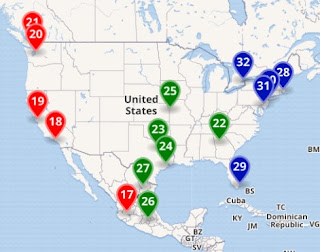The 2026 FIFA World Cup will be jointly hosted by Canada, Mexico, and the United States. The Bid Committee proposed a preliminary list of 23 candidate host cities across the three countries.
Here is the preliminary list of candidate host cities and stadiums for the 2026 FIFA World Cup:
Canada:
- Edmonton, Alberta - Commonwealth Stadium
- Montreal, Quebec - Olympic Stadium
- Toronto, Ontario - BMO Field
- Vancouver, British Columbia - BC Place
Mexico:
- Guadalajara - Estadio Akron
- Mexico City - Estadio Azteca
- Monterrey - Estadio BBVA
United States:
- Atlanta, Georgia - Mercedes-Benz Stadium
- Baltimore, Maryland - M&T Bank Stadium
- Boston, Massachusetts - Gillette Stadium
- Cincinnati, Ohio - Paycor Stadium
- Dallas, Texas - AT&T Stadium
- Denver, Colorado - Empower Field at Mile High
- Houston, Texas - NRG Stadium
- Kansas City, Missouri - Arrowhead Stadium
- Los Angeles, California - SoFi Stadium
- Miami, Florida - Hard Rock Stadium
- Nashville, Tennessee - Nissan Stadium
- New York/New Jersey - MetLife Stadium
- Orlando, Florida - Camping World Stadium
- Philadelphia, Pennsylvania - Lincoln Financial Field
- San Francisco Bay Area, California - Levi's Stadium
- Seattle, Washington - Lumen Field
- Washington, D.C.- RFK Stadium
The final selection of host cities and stadiums for the 2026 World Cup will be announced by FIFA in the future.
Why is the 2026 North American World Cup in 3 countries?
The decision to host the 2026 FIFA World Cup across three countries, Canada, Mexico, and the United States, was made as part of a joint bid submitted by the three nations. There are several reasons behind this decision:
- Increased cooperation and regional unity: Hosting a major sporting event like the World Cup can promote cooperation and unity among nations. By jointly hosting the tournament, Canada, Mexico, and the United States aim to strengthen relationships and foster collaboration in the North American region.
- Utilizing existing infrastructure: The three countries already have a significant number of stadiums, transportation networks, and other necessary infrastructure in place to host the World Cup. This reduces the need for extensive construction and infrastructure development, making it a more cost-effective and sustainable option.
- Expanding the reach and impact of the tournament: Hosting the World Cup in multiple countries allows for a broader geographic spread of matches. It provides an opportunity for fans across North America to experience the tournament without having to travel long distances, potentially increasing attendance and viewership.
- Promoting the growth of soccer in North America: The joint hosting of the World Cup can help promote and develop soccer in Canada, Mexico, and the United States. It provides a platform to showcase the sport, generate interest, and potentially increase participation levels, leaving a lasting legacy in the region.
The decision to host the World Cup across multiple countries is not unprecedented. The 2002 World Cup was co-hosted by South Korea and Japan, while the 2022 World Cup is scheduled to take place in Qatar. FIFA has shown a willingness to explore shared hosting arrangements to accommodate large-scale tournaments and facilitate broader global engagement with the sport.






